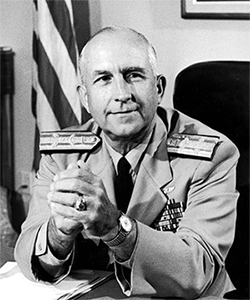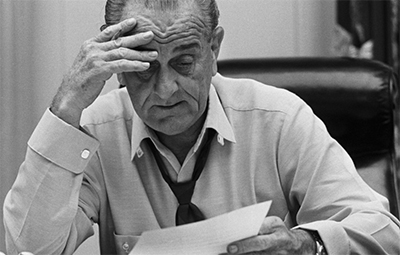
(ADM Thomas Moorer in 1964. Photo USN).
It was April Fool’s Day, 2010. The town of Topeka, Kansas had decided to re-name itself “Google” for some reason best known to the Mayor and the city council. Mac Showers was feeling a little housebound and was available to chat, and on a splendid day in the northern Virginia Spring, he decided to fire up the champagne-colored Jaguar saloon and drive across the street to the only saloon I have, the fabulous Willow Bar.
My only prank in honor of the spirit of the day was to show up at the office and pretend to work. Things had been busy in that curious way of the contracting business. One moment we had five proposals going to try to win work at the Defense Intelligence Agency, and then they were all submitted and most of us were still walking around with slack jaws and fatigue in our eyes. It is a strange business, and totally dependent on a bunch of GS-13 government drones.
I had a copy of a picture that Mac had given me when we were talking about the DESOTO patrols he had developed and the events that surrounded the Gulf of Tonkin incident.
“Admiral You showed me a photograph a few minutes ago of your Situation Room at CINCPAC. Admiral Tom Moorer was there, you were there, and a whole bunch of other people were. It is obviously off-duty hours, because one officer is in a very Hawaiian shirt. You said that it is a picture of the night that you were all waiting for word from Washington after the Tonkin Gulf incident. I wonder if you could give me some more context for all that- the things I have heard all concentrated on the events in the Gulf, not the reaction of the US Government and the Navy staffs that had to take action.”
Mac was wearing his aloha shirt under his sport jacket, an affectation that he preferred to demonstrate that he had spent the better part of a decade working in Pearl Harbor. He took a sip of Virgin Mary and said: “You’ll have to verify the date that the picture was taken, but I do recall that it was the date that we mobilized the staff in the evening that the reporting about the incident was available
“I looked it up, I must have been around August 8th, 1964, right?”
“That certainly would fit. That was about mid-tour for me at PACFLT, and Admiral Moorer was the commander-in-chief.”
“Mr. Rumsfeld told us we couldn’t say that any more. His position was that there was only one Commander In Chief, and he lives on Pennsylvania Avenue. I still can’t keep it straight.”

“Mr. Rumsfeld was a character even the first time he was SECDEF. We knew that President Johnson was going to attempt to get the authority to order retaliatory strikes against North Vietnam, so we pre planned that the staff would be mobilized and we’d all be present in the Op Center that evening. We had all the staff division heads there. The gentleman in the aloha-shirt was our assistant chief-of-staff for logistics. The Plans Officer was there and the Operations Officer was there with all of his officers. I was there with one or two assistants, and all other key members of the staff were present. The picture was taken at the time that we were maintaining our Seventh Fleet and air status board awaiting the word from Washington to launch the strikes. That word did come during the evening in Hawaii so it obviously was late at night in Washington. The strikes were launched, and the President, as I recall, wanted an immediate report on the effectiveness of the bombing. So, we stayed there, essentially all night, until the aircraft were recovered and we were able to provide reports back to Washington on the effectiveness of the strikes.”
“I was always a Bomb Damage Assessment guy. They must have used Viggies to get the post-strike imagery. Were the targets selected at COMPAC….hell, CINCPACFLT, then?
“Yes, I think we selected the targets, coordinated with Washington, of course, but I think we nominated the targets and carried out the strikes. This type of mobilization in the evening for these strikes obviously didn’t continue. I think we did do it two or three times in the beginning because we didn’t know what kind of reaction we would get. We knew the North Vietnamese were not able to react against our fleet units, but we didn’t know who else might react against our fleet units. So, we were prepared for any kind of reaction. That’s why we had the full staff mobilized and ready to do whatever was necessary. Over time, obviously, as these strikes continued and were repeated, they became routine and it wasn’t necessary for the PACFLT Op Center to be fully mobilized. Instead, it was done by the Seventh Fleet and carried out routinely.”
“So, the night of the picture you still that feeling of, “Crap, here may go the start of fthe war.” That must have been fairly alarming?”
“Vic, you are a master of understatement.”
“That’s your third war?”
“I missed the Korean War in that I was in London. I was about as far away from that as one can get. I was just as happy about that. It was an ugly one.”
“You don’t count the Cold War as one of them? I do.”
“Point taken. But really, the one that counted was 1941-45 for me.”
“Trust me, Admiral. You didn’t miss a thing in Korea.”
Copyright 2017 Vic Socotra
www.vicsocotra.com
